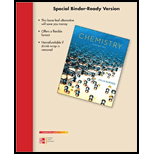
Concept explainers
Interpretation:
The representation of constitutional isomers,
Concept introduction:
cis-trans Isomers are an organic molecule that have double bonds. The attachment of two similar groups to the carbon on the same side is called cis-isomer, and if the attachment is on the different side, it is called trans-isomer.
When isomeric molecules have the same molecular formula but differ in bonding patterns and atomic organization, they are known as constitutional isomers.
Enantiomers are one of the two molecules that are a mirror image of each other and are non-superimposable.
In resonance structures, the electrons can move in order to help stabilize the molecule and should have the same number of electrons.
Want to see the full answer?
Check out a sample textbook solution
Chapter 25 Solutions
Chemistry - With Access (Looseleaf) (Custom)
- What is the name of the compound if it is one of the first 10 noncyclic, unbranched alkanes and what is the mass% of hydrogen in the compound?arrow_forward1-bromo-3-ethylcyclopentane exhibits geometrical isomerism. Draw structures of the two geometrical isomersarrow_forwardHow many stereoisomers are possible for this structure? How many chiral carbons are in the structure?arrow_forward
- Distinguish precisely, and in scientific terms, the differences among items in each of the following pairs or groups. a Organic chemistry, inorganic chemistry b Saturated and unsaturated hydrocarbons c Alkanes, alkenes, alkynes d Normal alkane, branched alkane e Cis and trans isomers f Structural formula, condensed line formula, molecular formula g Addition reaction, substitution reaction h Alkane, alkyl group i Monomer, polymer j Aliphatic hydrocarbon, aromatic hydrocarbon k Ortho-, meta-, para l Alcohol, aldehyde, carboxylic acid m Hydroxyl group, carbonyl group, carboxyl group n Primary, secondary, tertiary alcohols o Alcohol, ether p Aldehyde, ketone q Carboxylic acid, ester r Carboxylic acid, amide s Amine, amide t Primary, secondary, tertiary amine u Chain-growth polymer, step-growth polymerarrow_forwardWhich of the following pairs represent structural isomers, and which are simply the same compound? a. and CH3CH2CH2CH3 b. and CH3CH2CH2CH2CH2CH3 c. and CH3CH2CH2CH3 d. andarrow_forward
 Chemistry: The Molecular ScienceChemistryISBN:9781285199047Author:John W. Moore, Conrad L. StanitskiPublisher:Cengage Learning
Chemistry: The Molecular ScienceChemistryISBN:9781285199047Author:John W. Moore, Conrad L. StanitskiPublisher:Cengage Learning Chemistry & Chemical ReactivityChemistryISBN:9781337399074Author:John C. Kotz, Paul M. Treichel, John Townsend, David TreichelPublisher:Cengage LearningChemistry: Matter and ChangeChemistryISBN:9780078746376Author:Dinah Zike, Laurel Dingrando, Nicholas Hainen, Cheryl WistromPublisher:Glencoe/McGraw-Hill School Pub Co
Chemistry & Chemical ReactivityChemistryISBN:9781337399074Author:John C. Kotz, Paul M. Treichel, John Townsend, David TreichelPublisher:Cengage LearningChemistry: Matter and ChangeChemistryISBN:9780078746376Author:Dinah Zike, Laurel Dingrando, Nicholas Hainen, Cheryl WistromPublisher:Glencoe/McGraw-Hill School Pub Co Chemistry for Today: General, Organic, and Bioche...ChemistryISBN:9781305960060Author:Spencer L. Seager, Michael R. Slabaugh, Maren S. HansenPublisher:Cengage Learning
Chemistry for Today: General, Organic, and Bioche...ChemistryISBN:9781305960060Author:Spencer L. Seager, Michael R. Slabaugh, Maren S. HansenPublisher:Cengage Learning Chemistry: Principles and PracticeChemistryISBN:9780534420123Author:Daniel L. Reger, Scott R. Goode, David W. Ball, Edward MercerPublisher:Cengage Learning
Chemistry: Principles and PracticeChemistryISBN:9780534420123Author:Daniel L. Reger, Scott R. Goode, David W. Ball, Edward MercerPublisher:Cengage Learning





